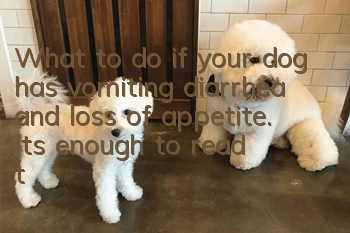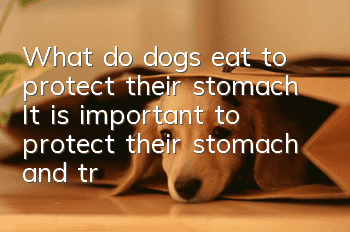What to do if your dog has vomiting, diarrhea and loss of appetite. It’s enough to read this article!

What should I do if my dog has diarrhea and vomiting?
Vomiting and diarrhea are the most common symptoms in dogs. They can occur individually or together. Vomiting and diarrhea can affect your dog by causing massive fluid loss, which can lead to dehydration, electrolyte imbalance, or acid-base imbalance. This article focuses on how pet owners can address this problem at home.
The following are general methods for treating vomiting and diarrhea:
1. If your pet vomits once or has a small amount of diarrhea, then eats normally without further vomiting, has normal bowel movements and acts playful, then this The problem may resolve itself.
2. If you identify any triggers, such as exposure to litter, changes in diet or plants your dog may be eating, try eliminating them.
3. If your dog vomits several times and has diarrhea and you cannot take your dog to your veterinarian (this is recommended), then you can try the following small methods:
Every 4 -Food will be served for 6 hours. Usually, when this happens, the digestive function of the stomach is abnormal, and the dog will continue to vomit even if he wants to eat. So, give your dog’s stomach a few hours to “rest.”
Pay close attention to your dog's vomiting and diarrhea
If your pet does not vomit after this period is over, provide small amounts of water (a few tablespoons at a time). Continue to provide small amounts of water for about 20 minutes until the pet remains hydrated. Don't let your dog drink too much water as it can cause vomiting.
If vomiting does not occur after offering small amounts of water, then you can gradually offer a bland diet.
Frequent but small feedings of a mild and easily digestible diet are often recommended, such as homemade rice or potatoes (as a carbohydrate source) and lean burgers, skinless chicken or low-fat cheese (as a protein source), Don't overfeed. Feed a meatball-sized portion, and if there is no vomiting, offer a smaller amount after about an hour. You can gradually increase the amount and reduce the frequency as your dog tolerates it.
Many veterinarians recommend PepcidAC® (generic name famotidine) to reduce stomach acid. This helps many pets. The most commonly used dose is 0.25 to 0.5 mg/pound (0.5 to 1.0 mg/kg) every 12 to 24 hours. A 20-pound dog should receive approximately 5 to 10 mg (total dose) once or twice daily. This is an oral medication that can be found in most pharmacies in the antacid section. Pepcid (famotidine) does not require a prescription. It is usually used for 3 to 5 days. You can buy some and keep them at home in case of emergency.
If your dog has severe diarrhea and vomiting and is often lethargic or vomiting or has diarrhea, it is very necessary for you to see a veterinarian.
Note: Do not give any medication without consulting your veterinarian. If you don’t know the ingredients of the medicine, it is likely to be counterproductive.
I don’t know if this article is useful to you. If it is, please remember to bookmark it. You will definitely use it!
- How to tell if your dog is fat? Is your dog overweight?
- Will your dog catch a cold if you blow the air conditioner? What should you do if your dog catches a cold if you blow the air conditioner?
- The dog's mouth bites and shakes. Why does the dog's mouth occasionally shake and bite?
- How to cut a dog's hair? Do you know how to cut a dog's hair correctly?
- Can dogs eat raw eggs? Why can’t dogs eat egg whites?
- Common Dog Problems in Summer How to Deal with Different Dog Problems
- How to keep dogs away from skin diseases. If you do this, will you see if your dog will still be infected with skin diseases?
- What causes anorexia in dogs? Dogs will become anorexic due to lack of exercise. Hounds run at least 5KM every day.
- Can dogs eat liver? What should you pay attention to when giving liver to your dog?
- Can canine herpes virus be transmitted to humans? Owners should not be too nervous



